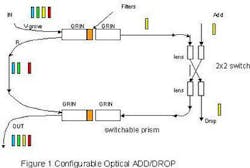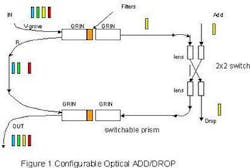Hybrid photonic integration
Hybrid photonic integration may become increasingly important in controlling manufacturing costs and delivering multiple functions.
By YALE ZHANG, PhD
Alliance Fiber Optic Products Inc.
The current trend in the fiber-optics industry has been to integrate multi-functional components into a single component or module. Integration offers many advantages over splicing discrete components together, including improved optical performance, increased stability, smaller footprint, and lower manufacturing costs.
Tremendous progress has been made in monolithic photonic integration techniques such as micro-electromechanical systems (MEMS) and planar lightwave circuits (PLCs). However, these technologies may not yet be mature enough for applications that require Telcordia-rated performance. In the meantime, fiber-optic network service providers need to optimize the capacity of their installed plant, while increasing the value of the services offered.
Conventional discrete components, such as thin-film-filter-based DWDMs, still play an important role in current photonic systems, particularly in metropolitan and access networks, due to their maturity, low cost, and stability. To integrate such discrete components into a module or subsystem, system companies purchase the components from component vendors, then splice or connect them into a module for their systems -- a practice that can be costly in terms of labor and test protocols.
The optimized use of all available technology platforms is a prerequisite to meet the demands of the all-optical network. Hybrid integration of discrete components offers the best solution for practical applications.
Given that optical add/drop is one key to achieving an all-optical network, a pertinent example of hybrid integration is a switchable optical drop/add (SODA) device.
Current view
Optical add/drop multiplexing is used to add and drop one or more wavelength channels or bands at a network node. Increased bandwidth needs have driven increased use of optical metropolitan and access networks, after proven successes in long-haul point-to-point networks. In access and metropolitan networks, communication signals are transmitted over a limited geographic area to various nodes within the network.
Most optical add/drop multiplexing schemes are static. A key driver to the provisioning of higher-value add services at the carrier level is the ability to remotely reconfigure optical adds/drops in real time. The ability to configure wavelengths remotely allows carriers to customize services and provide higher-margin services to their customers.
Current optical add/drop devices are essentially passive components, and lack switching and power control. To achieve reconfigurable capability, a 2x2 optical switch or two 1x2 optical switches are used to control the add and drop port(s) (Figure 1). In the past, the mux and demux functions have primarily been performed by thin-film filters.
A single-channel optical add/drop is a four-port passive optical device that includes two single-channel DWDM filters. The configured channel wavelength is fixed at the design stage to conform to network requirements. The reflect channel of the drop filter is spliced to the common port of the add filter to enable the express channel. The wavelength of interest is transmitted through the drop filter and proceeds to a 2x2 switch. When the 2x2 switch is positioned at bar mode, the configured channel joins the express channels. When the 2x2 switch is positioned at cross mode, the configured channel is dropped, and new signals with the same wavelength can be added.
Thin-film filters provide excellent temperature stability and reliability for such applications. However, the configured channel has high insertion loss in the bypass mode, since it must pass through two DWDM channels and one 2x2 switch.
Alternative methods to achieve the configurable optical add/drop function include fiber Bragg gratings (FBGs), MEMS, and PLCs. FBGs provide filtering functionality through reflection. Two optical circulators are normally required to drop the reflected signal and add a new signal. The switching capability is provided by wavelength tuning of the grating. FBG, MEMS, and PLC technologies are less mature, have higher losses, are more costly than an opto-mechanical switch combined with thin-film filters, and have not been deployed significantly in metropolitan or access networks.
All of today's commonly used methods have several disadvantages -- a large footprint and high cost associated with interconnecting diverse components. Particularly, the opto-mechanical switch combined with thin-film filters has lower performance due to uneven power distribution for the express and configured channel.
Hybrid integration
To meet these challenges, hybrid integration accomplishes reconfigurable add/drop to and from DWDM traffic with a single device. The device can be used to add and drop the selected wavelength (or band) or to let all the channels through the device with minimal insertion loss. This approach leads to a compact, high-performance component that is plug-and-play ready. This reconfiguration is a typical example of the benefits of hybrid photonic integration technique.
In Figure 2, a switchable optical add/drop device includes first and second same reflection channel (R-channel) subcomponents opposite each other, two collimators performing in-and-out functions, respectively, and a movable prism to define the switchable optical path. The color blocks represent different DWDM wavelengths or channels. The R-channel module includes a GRIN lens with a DWDM filter.
The multiplexed signal enters the input R-channel with the chosen wavelength passing through the filter and along a first path directly toward the output R-channel. The balance of the signal is reflected in the "express path" that enters the second R-channel from the side opposite the corresponding filter.
The prism is can be switched to the position where it blocks the transmitted path and guides the transmitted wavelength toward the drop collimator. It simultaneously guides the wavelength to be added, if desired, from the add collimator to the second collimator. Under these conditions, the added wavelength channel joins the express wavelength channels from the second path to leave the second collimator via the "out" port.
Alternatively, when the prism is moved to the alternative position above the transmitted beam, the beam enters the second collimator from the filter side, and joins the express path, leaving the second collimator via the out port. The device essentially integrates the switching function and the optical add/drop function.
When the prism is present, the device drops a single wavelength to the drop port through the prism. In the meantime, the same wavelength with a different signal can be added through the add port. When the prism is removed, the dropped wavelength passes the second identical DWDM filter and combines with the express channels from the routed path. In this case, the device does not affect the spectra of the channels, and no wavelength is dropped or added. This is the bypass mode.
Improved performance
Since SODA integrates switching and add/drop functions onto a single substrate, optical performance is improved over conventional methods that collimate and focus the beam several times in the optical path. In the conventional OADM approach, the configured channel at the bypass mode propagates though two DWDM bare channels and one switch. This DWDM channel usually consists of two GRIN lenses and a DWDM filter. The switch normally contains two pairs of collimators and a switching device, such as a prism or mirror. The optical pass channel passes through three pairs of collimators and two DWDM filters, which can introduce insertion loss of between 2.0 and 3 dB, depending on the manufacturer. In addition, an attenuator is frequently required to balance the configured channel with the express channel.
In the SODA design, the optical pass channel only passes through one pair of collimators and two DWDM filters, and introduces a typical insertion loss of 1.15 dB. This low-insertion-loss channel matches well with the typical express channel loss of 0.9 dB, which removes the need for an attenuator to balance configured and added channels.
The spectrum of the in port to out port, at bypass mode, for a 100-GHz DWDM filter-based SODA is shown in Figure 3. To perform this measurement, a broadband light source is coupled into the in port. An optical spectrum analyzer is used to analyze the spectrum at the out port. The insertion loss value of the configured channel is then similar to the express channels. In addition to improved performance, hybrid integration offers lower manufacturing costs since fewer parts are used. The mechanical dimension of the device is also smaller than is required in conventional methods.
The performance advantage of the SODA design becomes even more obvious when multiple channels are cascaded together. Modules that switch a small number of channels can be mounted on a circuit board without an attenuator to balance power. In addition to the compact size, optical performance is improved in terms of balancing power and insertion loss. The flat loss over the pass band of each channel ensures minimal distortion of optical signals. The polarization dependent loss (PDL) and polarization mode dispersion (PMD) are not a problem for the thin-film filter and switch technology. Switching speeds and repeatability for opto-mechanical switch methods are very adequate for all-optical network applications.
Packaging
Packaging of multiple functional components into a single device offers several challenges. The optical layout of the SODA device is very similar to standard optomechanical 2x2 switches, except that two of the collimators have DWDM filters. The manufacturing complexity of this process is similar to the mature 2x2 switch, which makes the SODA more suitable for passing the standard of Telcordia GR tests. Very successful results have been obtained from this current SODA design.
Hybrid photonic integration is a key step in the control of manufacturing costs. The delivery of multiple functionalities and products based on the concept will increase in response to demand from optical module vendors.
Yale Zhang, Ph.D., is the R&D manager of wavelength management products at Alliance Fiber Optic Products Inc. (Sunnyvale, CA).

